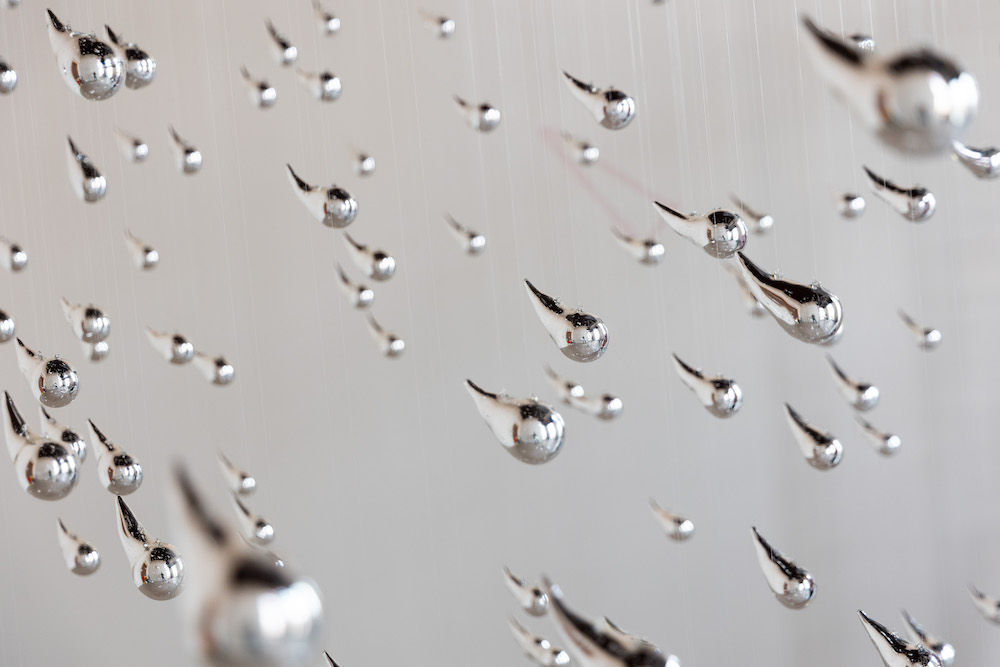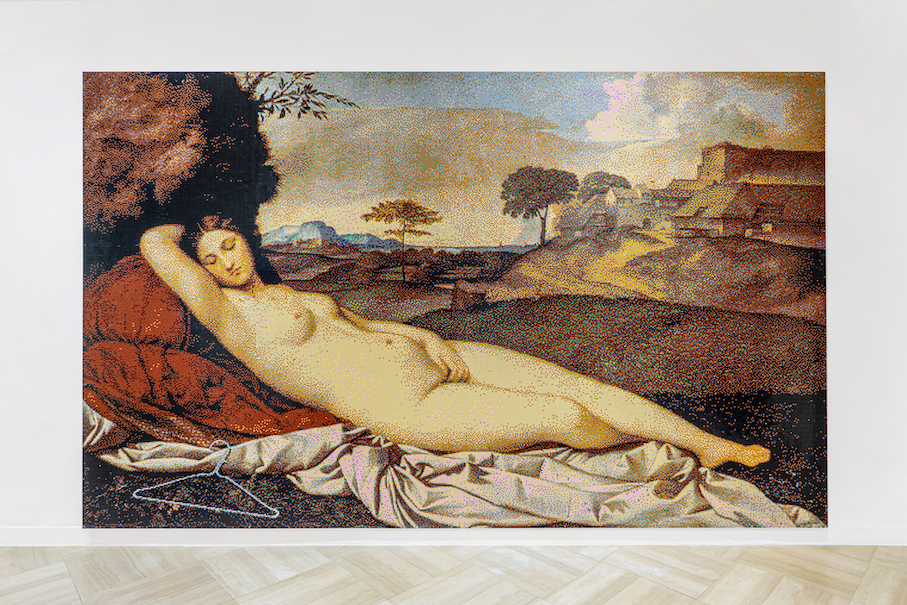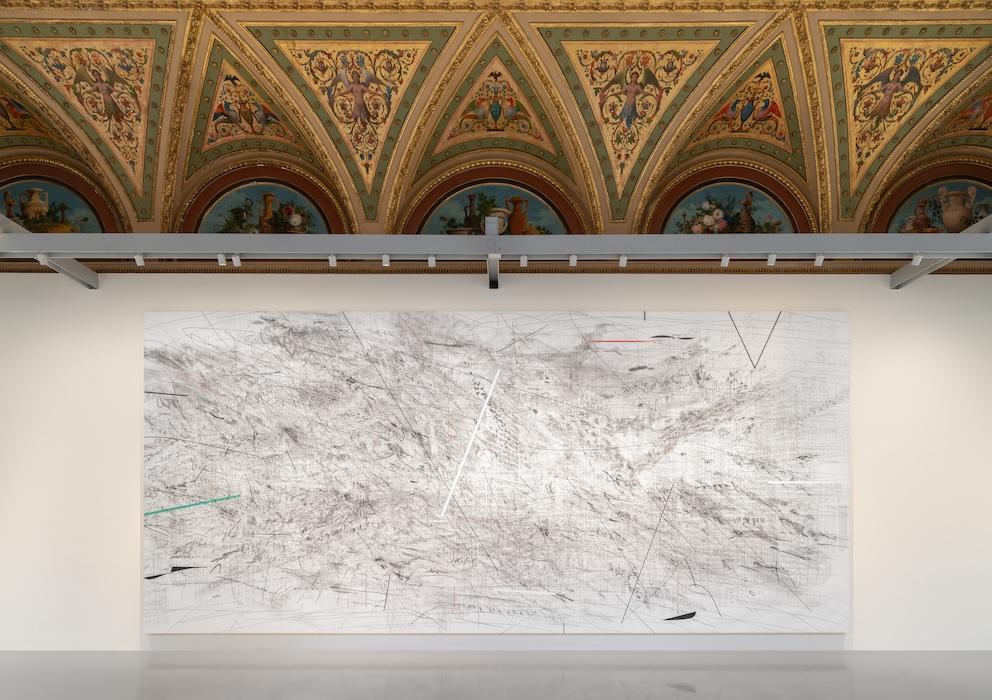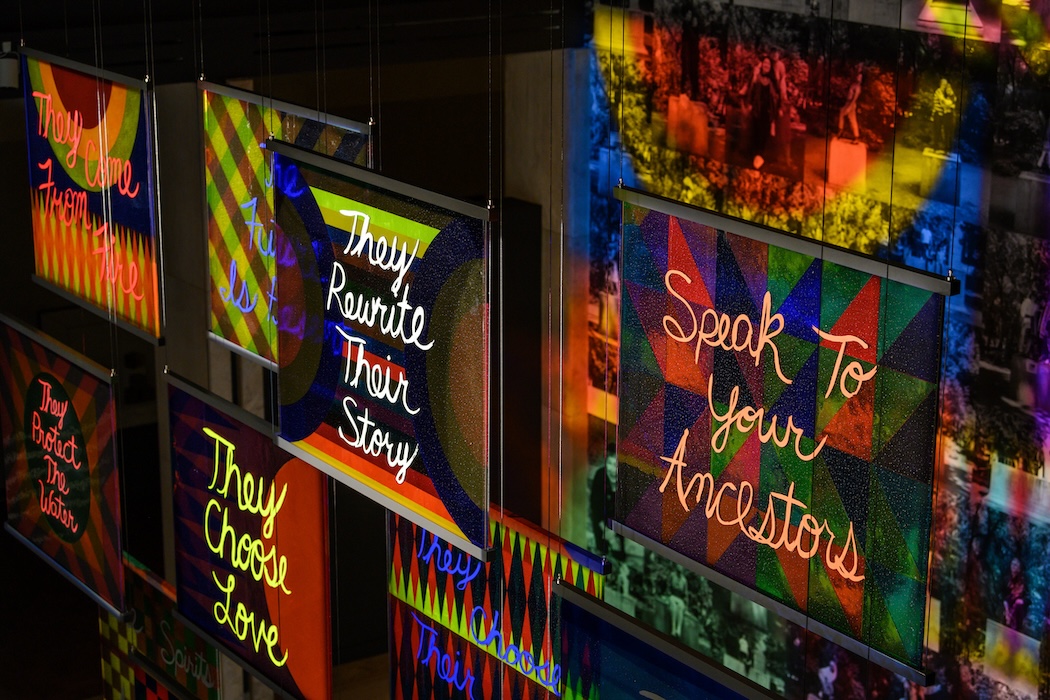Spearheaded by the Berggruen Arts & Culture Foundation, established by the visionary collector and philanthropist Nicolas Berggruen, Palazzo Diedo stands as an embodiment of the eternal power of art to bridge divides and transcend time.
During the past two years, Berggruen Arts & Culture has concluded a substantial renovation of Palazzo Diedo, demonstrating sensitivity to its historic origins while preparing palazzo for a fresh commencement as a realm of creativity and enlightenment. Two notable fresco cycles and a Roman capricci—scenes blending historical and fictional components—crafted by Francesco Fontebasso (1707-1769) and Costantino Cedini (1741-1811) have undergone comprehensive restoration.
Palazzo Diedo Opens its Doors in time for the Venice Biennale
As the city hosts the 60th Venice Biennale, Palazzo Diedo’s inaugural programming marks a pivotal moment in Venice’s artistic resurgence. It represents a bold commitment to fostering dialogue between contemporary creativity and the rich tapestry of history, seamlessly weaving together the threads of East and West. From its grand halls to its intimate corners, Palazzo Diedo pulsates with the promise of artistic exploration, offering a canvas for resident artists to breathe life into its storied walls.
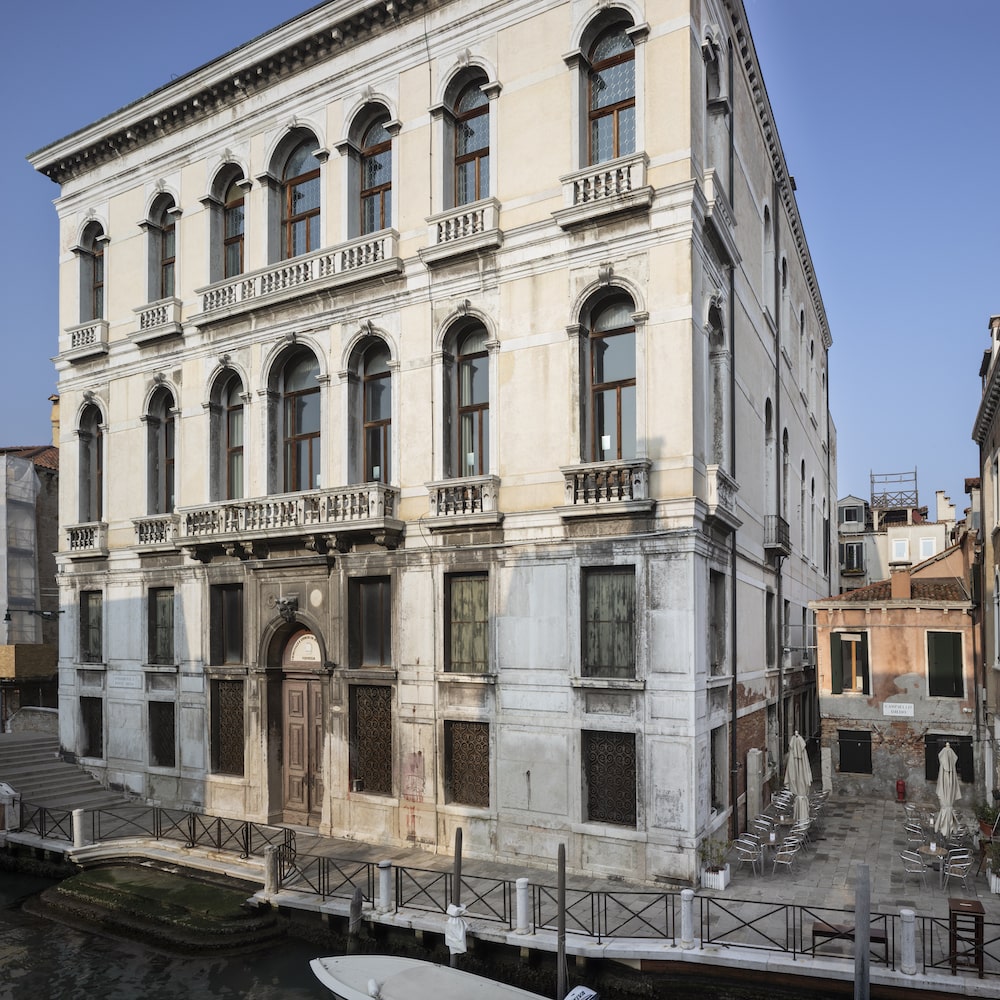
Palazzo Diedo. Photo by Alessandra Chemollo. © Berggruen Arts & Culture: Palazzo Diedo.
With partnerships forged with prestigious institutions such as New York City’s The Kitchen and the esteemed Polaroid Foundation, Palazzo Diedo transcends boundaries, embracing innovation while paying homage to tradition. Through exhibitions, events, and artist residencies spanning five levels and a sprawling 4,000 square meters, this cultural heaven will visitors on a journey of discovery, where the echoes of the past converge with the vibrant pulse of the present.
“Venice has historically been a catalyzer for creativity, ideas, experimentation, and exchanges. With Berggruen Arts & Culture, we aim to revive the making of artifacts, to animate the extraordinary treasure which is Palazzo Diedo,” said, Nicolas Berggruen, collector and founder of the Berggruen Institute. “Together with the Berggruen Institute, which hosts debates and a residency program at Tre Oci, we see Venice again as a generator of culture and ideas. ‘Janus’ symbolizes our commitment to build on the past in a contemporary way.”
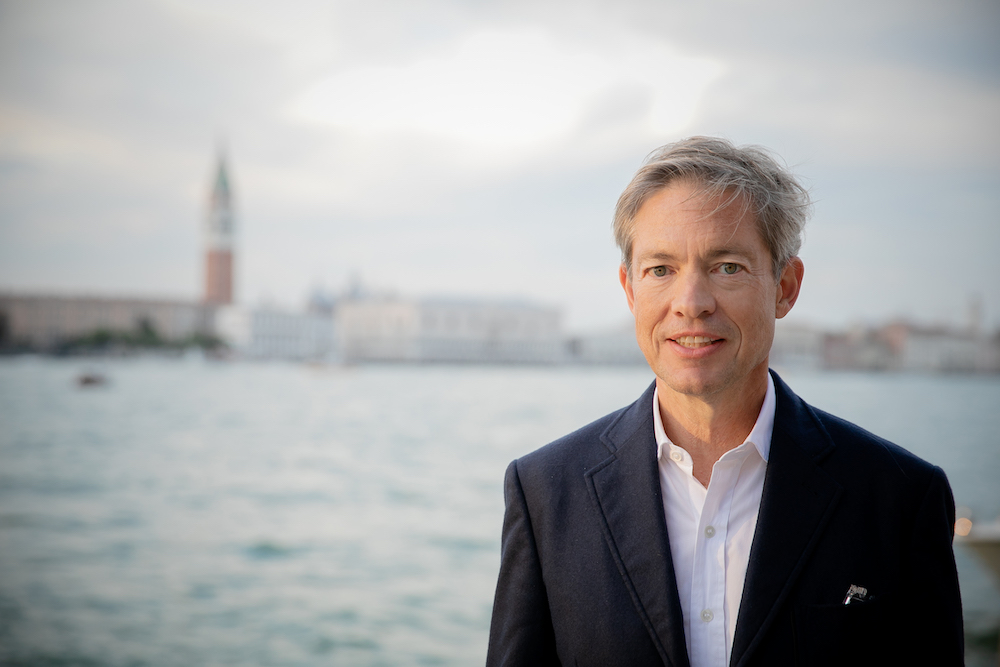
Portrait of Nicolas Berggruen. © Berggruen Arts & Culture: Palazzo Diedo.
“Janus” Inaugurates Palazzo Diedo
The debut show, “Janus,” brings together site-specific works crafted by eleven globally celebrated artists including Urs Fischer, Piero Golia, Carsten Höller, Ibrahim Mahama, Mariko Mori, Sterling Ruby, Jim Shaw, Hiroshi Sugimoto, Aya Takano, Lee Ufan, and Liu Wei.
The artworks are intricately woven into the fabric of the 18th-century palazzo structures, originally designed by architect Andrea Tirali and once the magnificent residence of one of Venice’s prominent families. This architectural marvel, which has also served as a revered institution including a primary school and court, is the fertile ground for their inspiration. Drawing from the rich legacy of Venice, their works are imbued with the essence of traditional crafts, ranging from intricate frescoes to the luminous artistry of Murano glass, opulent fabrics, and the intricate patterns of Venetian floor designs. Moreover, the exhibition draws inspiration from Janus, the Roman deity of beginnings, whose dual visage—one looking forward and the other backward—symbolizes the bridge between historical and contemporary realms, a theme echoed throughout the exhibition.
As visitors step into Palazzo Diedo, they are greeted by the installation of Sterling Ruby LANTERN. It is an homage to the street lighting that has illuminated Venice’s streets and alleyways since the twelfth century. Additionally, the tapestries titled WINDOW of Declinism 1 and WINDOW of Declinism 2 continue the artist’s existential inquiry into the traditional motif of peering through a window. Assembled over years of meticulous curation and exploration into the rich tapestry of textile history, these works show repurposed, artisanal fishing nets sourced from a family in Burano. The family’s profound dedication to preserving this age-old tradition of hand-making fishnets spans generations, infusing each piece in Sterling’s work with a deep sense of heritage and craftsmanship.
Site-Specific Works by Liu Wei, Urs Fischer, and Jim Shaw
As for Liu Wei’s Speculation No.2 (2024), it delves into a synthesis of visual and cognitive elements, employing materials and shapes reminiscent of ancient times. The artwork comprises a metallic sphere and a hollowed structure evocative of cave formations. Emerging from this cavernous structure is the partial figure of a lion, integrated into the sculpture itself, while a snake coils around its form, extending beyond the primary structure and engaging with the viewer’s surroundings.
Wei’s art shows a fascination with delving into the essence of aesthetics, pondering over the prevalent Western influence in shaping the aesthetics of Chinese contemporary art. Through his works, such as the series titled “The East” and its correlation with “Speculation No.2,” Wei ventures into an exploration of aesthetics, challenging conventional frameworks and proposing an alternative narrative. Within these artworks, Liu Wei prompts viewers to contemplate a landscape imbued with delicate hues, evoking reflections on the intricate fabric of “the East” as perceived through the viewer’s imaginative lens.
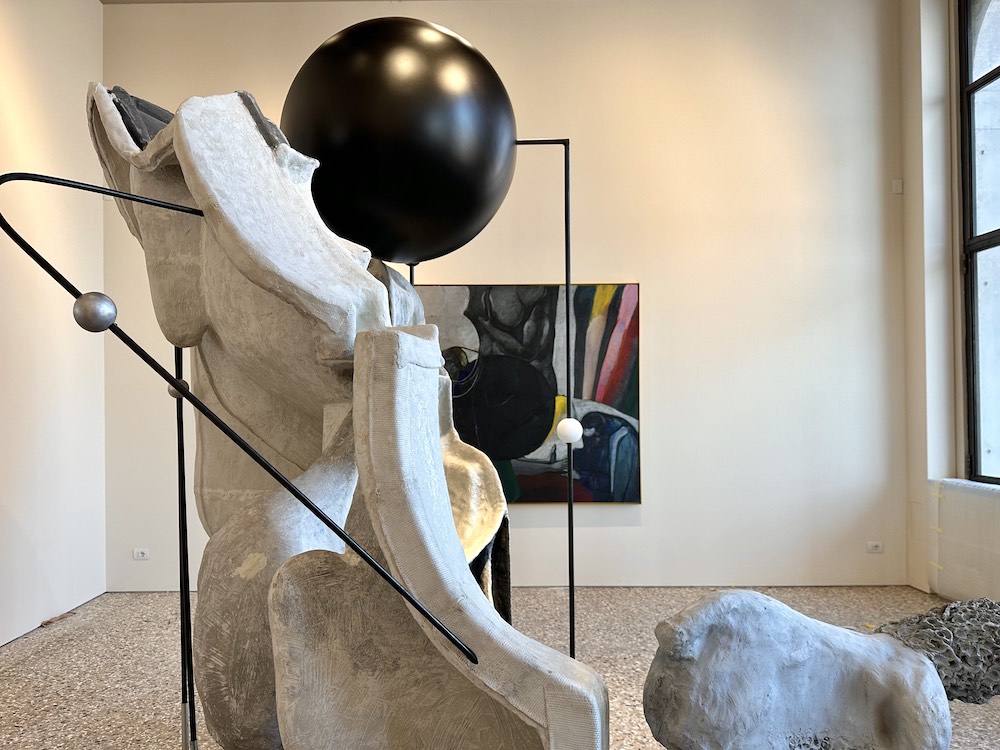
Liu Wei, “Speculation N. 2,” 2024. Photo by Massimo Pistore. © Liu Wei, Lehmann Maupin New York, Seoul, London and Berggruen Arts & Culture: Palazzo Diedo.
Another site-specific installation Throw a Dice by Wei, crafted specifically for the ground floor of Palazzo Diedo, represents a continuation of his exploration into architectural environments and the human form. Within this sculptural piece, the very material utilized in its creation assumes a central role, blurring the lines between subject and medium. It is a fresh addition to Wei’s oeuvre; it delves into profound philosophical inquiries regarding the essence of humanity — an entity simultaneously bound by and transcendent of the laws governing existence.
Drawing inspiration from the architectural milieu that envelops it, the installation adeptly collapses the boundaries of time, weaving together past and present to reconstruct the human body within its historical and temporal framework. For the artist, the significance of antiquity extends beyond mere historical retrospection, encompassing instead the entirety of past and future.
As Wei’s thought-provoking exploration of human existence intertwines with the architectural narrative of Palazzo Diedo, the gallery’s space further unfolds with the visionary works of Urs Fischer and Jim Shaw. Fischer has conceived Good Luck Peanuts, a permanent ceiling installation adorning Palazzo Diedo. This striking piece features a meticulously crafted aperture in the ceiling, offering a startling glimpse of the sky beyond. Additionally, Fischer’s temporary exhibition unveils “Omen,” an awe-inspiring array of 600 droplets meticulously fashioned from hand-blown mirrored glass. Suspended from the ceiling, these droplets cascade through the room with the grace of falling raindrops.
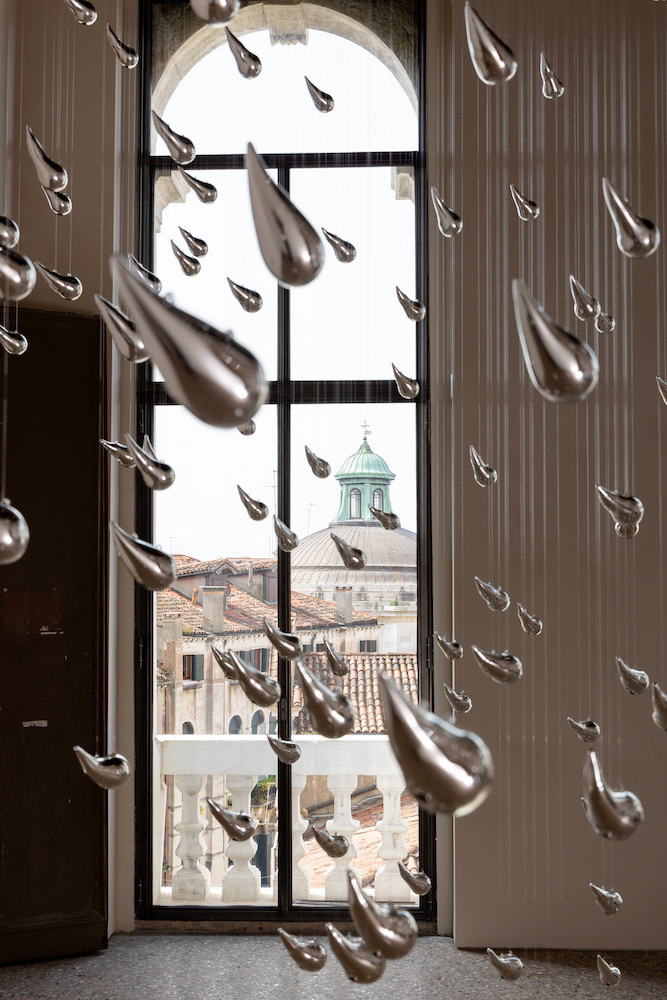
Urs Fischer, “Omen”, 2024. Photo by Massimo Pistore. © Gagosian and Berggruen Arts & Culture: Palazzo Diedo.
In parallel, the creative vision of Shaw draws inspiration from mythology, surrounding Alexander the Great. Shaw’s latest masterpiece adorning the palazzo’s ceiling depicts a vivid tableau of Alexander’s divine anointment as the son of the God Amun, within the sacred walls of the Siwa oasis temple. Surrounding this central fresco, an entrancing array of grotesques breathes life into the fantastical men and creatures that Alexander encountered on his legendary quest for the global conquest.
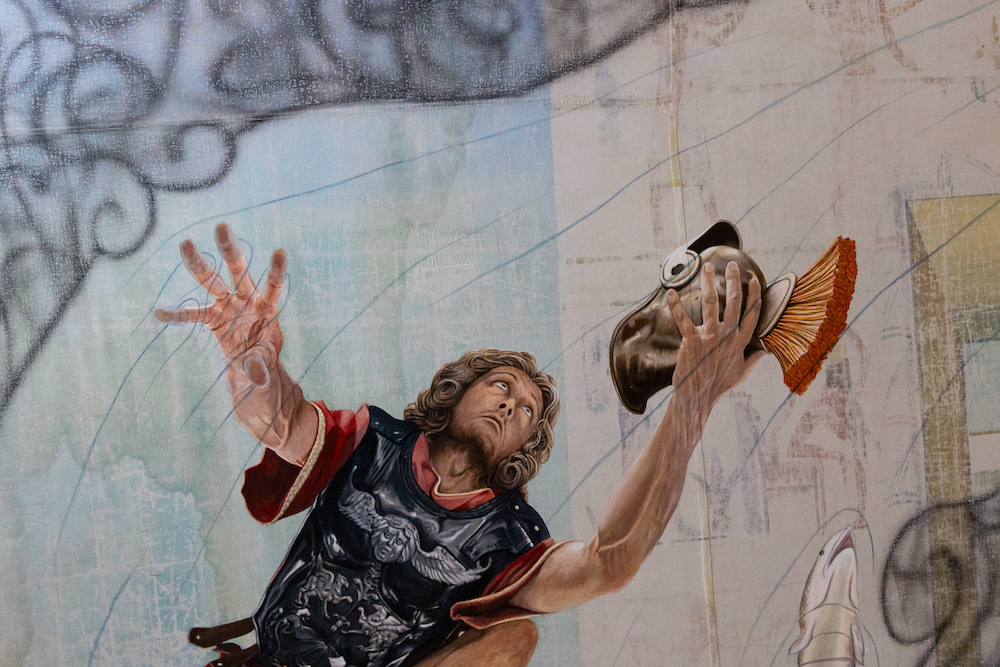
Jim Shaw, “The Alexander Romances”, 2024. Photo by Massimo Pistore. © Jim Shaw Studio and Berggruen Arts & Culture: Palazzo Diedo.
Inspired by profound schisms in human history, including the unearthing of psilocybin and the development of the atomic bomb, Shaw ingeniously presents The Split Fountain. This dual representation is a juxtaposition of a mystical mushroom on one facet and an atomic bomb mushroom cloud on the other. Accompanying this sculpture, Shaw introduces a series of 10 psychedelic prints, inspired by the visions and dreams of Carl Jung, as well as Macluhan’s analysis of James Joyce‘s thunder echoes from Finnegan’s Wake.
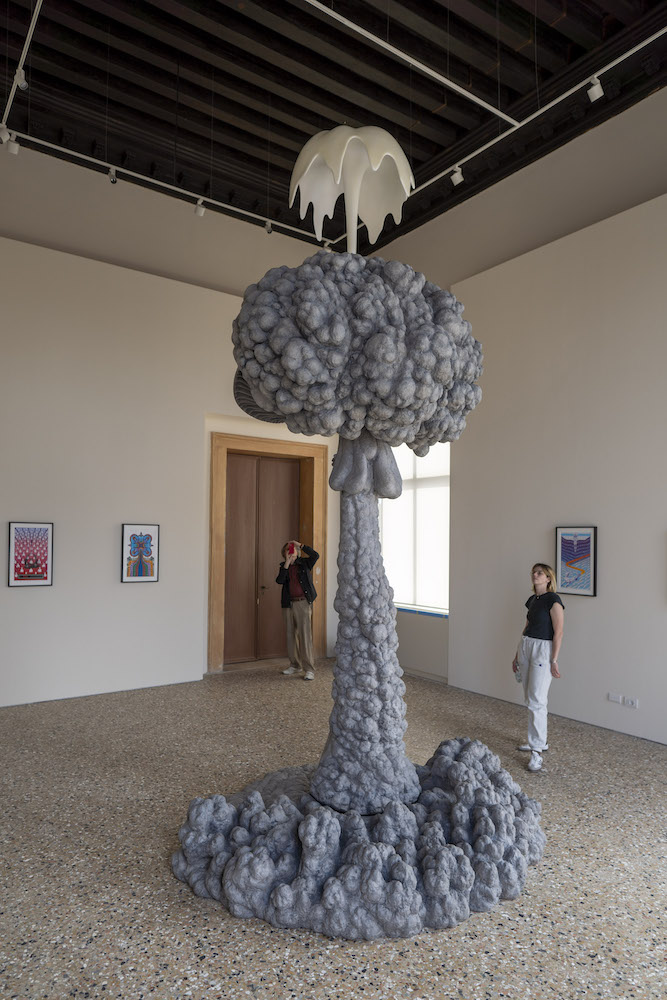
Jim Shaw, “The Split Fountain”. Photo by Massimo Pistore. © Jim Shaw Studio, Gagosian and Berggruen Arts & Culture: Palazzo Diedo.
Lee Ufan’s “Beyond Venice”
As the ethereal ambiance of Palazzo Diedo continues to unfold, the artistic journey takes a whirlwind turn with the works of Lee Ufan, a luminary in the realm of Japanese Mono-Ha school. Renowned for his profound exploration of space and materiality, Ufan graces Palazzo Diedo with his transcendent series titled “Beyond Venice.” This collection, comprising a permanent ceiling fresco and temporary installations spanning multiple rooms, brings visitors into a realm where the boundaries between presence and absence, action and inaction, blur into a captivating dance of perception and experience.
At the core of Ufan’s oeuvre lies a deep reverence for the process of creation, the intrinsic qualities of materials, and the profound engagement of the viewer. The central theme revolves around transcendence: his focus lies not in crafting mere artistic pieces but in using art as a means to illuminate the encompassing stillness and void, which he eloquently calls, “the great dazzling cosmos.”
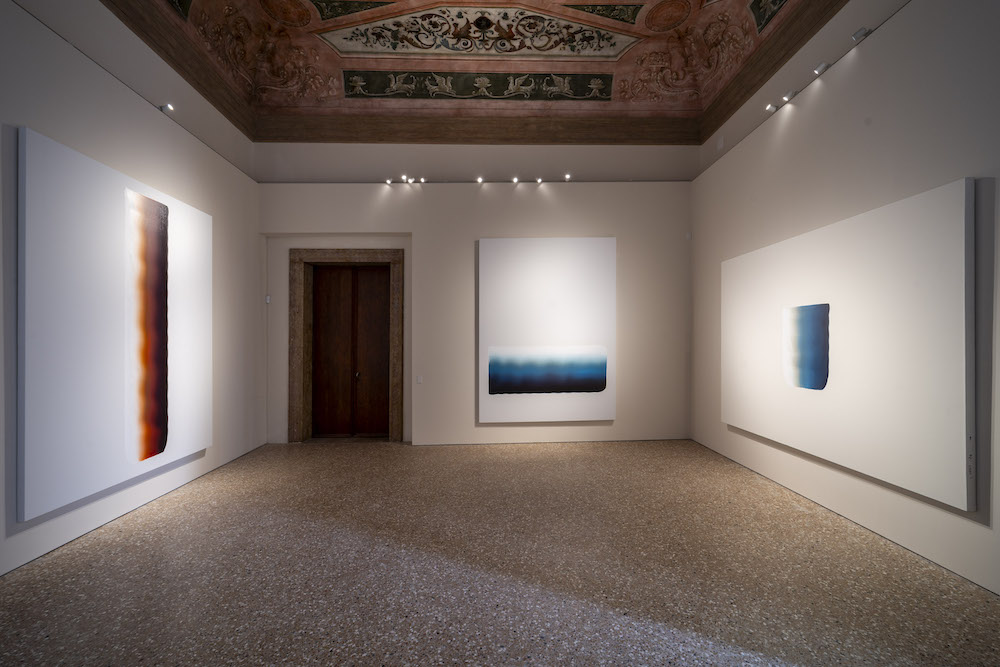
Lee Ufan, “Beyond Venice”, 2023-2024. Photo by Massimo Pistore. © Lee Ufan Studio, Lisson Gallery and Berggruen Arts & Culture: Palazzo Diedo.
Apart from these site-specific works, “Janus” at the Palazzo Diedo is the first opportunity to see Mariko Mori’s Peace Crystal. It is a prayerful ode to peace, to be revealed to the public in the Giardini of Palazzo Corner della Ca’ Granda in San Marco, one month into the biennale on May 13. The work marks the culmination of a trilogy under the auspices of the Faou Foundation. The exhibition at Diedo does not only unveil this masterwork but also offers an immersive experience. It includes a cinematic portrayal of preceding installations in Japan and Brazil, alongside a model and scroll of the Peace Crystal, designed to offer viewers a profound understanding of its significance.
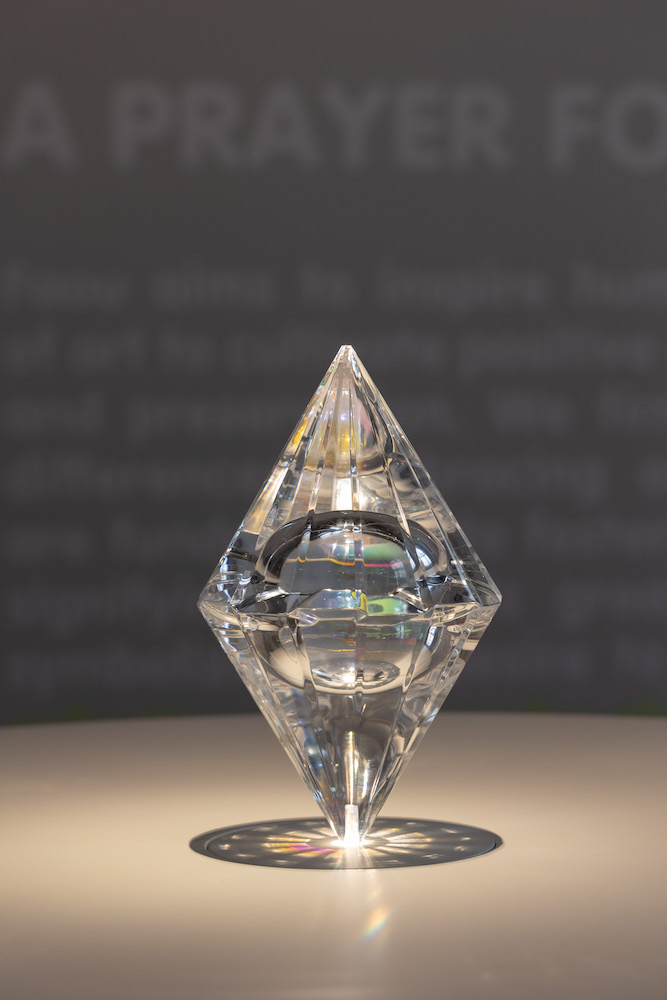
Mariko Mori, “Peace Crystal”, 2016-2024. Photo by Massimo Pistore. © Mariko Mori, Faou Foundation and Palazzo Diedo: Berggruen Arts & Culture.
Partnerships with The Kitchen and Polaroid Foundation
Concurrently, The Kitchen showcases a solo exhibition by the prodigious talent Rhea Dillon (born 1996). Originally from London, Dillon, both artist and writer, delves deep into the conceptualization of Blackness within the realms of aesthetics and theoretical discourse. Building upon their prior collaboration featuring Dillon’s film, Browning 2025, The Kitchen embarks on a fresh exploration with Dillon in a new constellation of sculptural creations.
Another exciting project relates to the Polaroid Foundation. The project involves inviting the exhibiting artists to craft an original work using the world’s largest instant camera, the Polaroid 20×24. Noteworthy personas such as Andy Warhol, Robert Rauschenberg, Mary Ellen Mark, Jim Dine, Chuck Close, Maria Magdalena Campos-Pons, Mickalene Thomas, Robert Frank, Robert Mapplethorpe, and Sally Mann have all previously worked with this iconic camera. John Reuter, who has operated the camera since 1980, will provide support to the artists as they capture images measuring 20 x 24 inches (50 x 60 cm) for Palazzo Diedo.
“Venice is world-renowned for exhibiting contemporary art and for its culture of historic art traditions. Palazzo Diedo will add to that already impressive landscape through its new galleries as well as bringing something new – artists’ studios,” said Mario Codognato, the Director of Berggruen Arts & Culture and curator of the exhibition. “The spaces will enable artists to submerge themselves in the traditions and atmosphere of a city forever located in another era in extended residencies. I am truly excited to see what will emerge.”
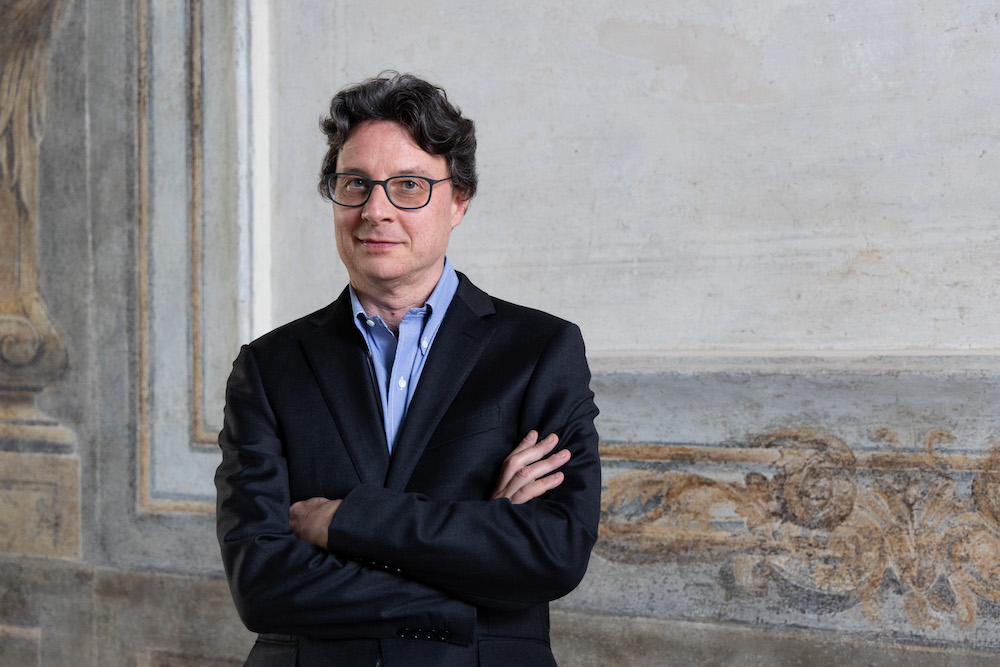
Mario Codognato. Photo by Massimo Pistore. © Berggruen Arts & Culture: Palazzo Diedo.



